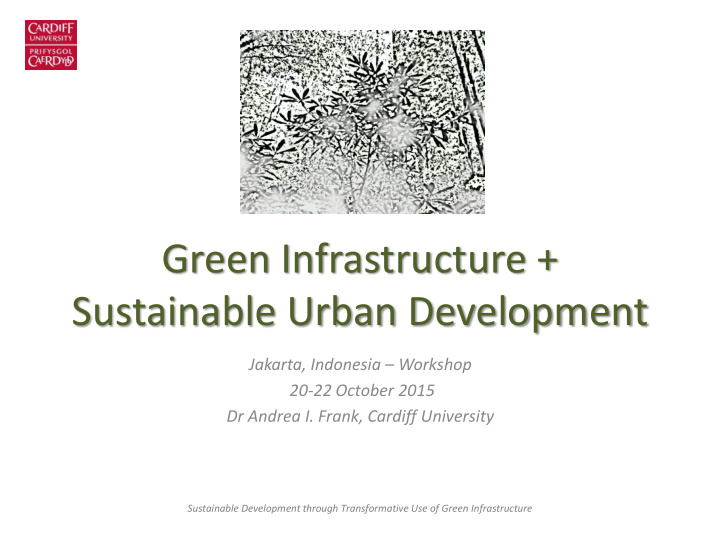



Green Infrastructure + Sustainable Urban Development Jakarta, Indonesia – Workshop 20-22 October 2015 Dr Andrea I. Frank, Cardiff University Sustainable Development through Transformative Use of Green Infrastructure
Overview 1. Defining ‘Green Infrastructure’ 2. New, emerging paradigm 3. Benefits of Green Infrastructure 4. Application examples from Europe + North America 5. Lessons & Transferability a. A need for locally, regionally sensitive solutions Sustainable Development through Transformative Use of Green Infrastructure
1. Defining GI • All the green and blue spaces in a place – Parks, private gardens, hedges, fields, woodland, trees, green roofs/walls, wetlands, ponds, rivers etc. • Not roads, sewage canals… Sustainable Development through Transformative Use of Green Infrastructure
1. Defining GI cont’d . • narrow Green infrastructure is an approach to wet weather management that is cost-effective, sustainable, and environmentally friendly. (EPA, US) • “ a network of multi-functional green spaces, both new and existing, both rural and urban, which supports the natural and ecological processes and is integral to the health and quality of life of sustainable communities ” (Natural England) • “Green” infrastructure as infrastructure which contributes to a place’s sustainability (possibly also smart technology) Holistic/ integrated Sustainable Development through Transformative Use of Green Infrastructure
2. GI: New paradigm?! • Green spaces have always been important in planning (e.g. garden city/ urban park movement…) • BUT GI is broader – not just protection/conservation of green spaces – Creating/designing/enhancing green spaces – Not seeing benefits individually but for the greater society (green spaces/vegetation contribute to human well-being, reducing air pollution, providing food/income etc.) Economy/society – Moving from anthropocentric to ecocentric … humans Environment/biosphere Sustainable Development through Transformative Use of Green Infrastructure
2. GI: New planning paradigm? Connected/Integrated GI approach Regional level Multi-functional Unifunctional Building Traditional level approach Discrete/separated Sustainable Development through Transformative Use of Green Infrastructure Image: Adapted from Lennon and Scott, 2014
3. Benefits • Well designed green areas support biodiversity • Green roofs can aid insulation to reduce cooling/heating of buildings • Parks for leisure, exercise, health and well-being • Vegetation to combat air pollution and urban heat islands • Slow water run-off, natural filtration of water Sustainable Development through Transformative Use of Green Infrastructure
4. Application Examples • Improving urban climate: air quality & cooling in Stuttgart, Germany • City suffers from pollution and increasingly hot summers – Multiple actions: increasing public transit, incentives for car sharing and electric cars, (prohibiting truck traffic in the city on worst days); and urban infrastructure – Subsidizing green roofs on buildings – No building zones to have cool air corridors to facilitate air exchange – Urban parks support also air cooling Sustainable Development through Transformative Use of Green Infrastructure
5 . Application Examples, cont’d. • Improving water management in Cardiff, UK (2 mio GBP investment) • Local Water company, city planners, engineers and community redesign streets with GI to reduce costs for rainwater run-off filtration • Less water to be pumped over 8 miles (ca. 250 000 GBP savings / year) Sustainable Development through Transformative Use of Green Infrastructure
5. Lessons & Transferability? In summary: • Green infrastructure can help improve the sustainability/resilience of cities & regions • Policy can hinder or encourage • But requires and integrated and holistic approach to planning and design • Working with institutions (who is responsible for what) • Working with professionals (need to understand local practice and culture) • Working with end users (need to think about needs) and communicate • Regionally sensitive applications (need to understand the science) – E.g. (what kind of tree species are suitable for the locality, soil etc) – How does the hydrology work? Etc. etc. Sustainable Development through Transformative Use of Green Infrastructure
Thank you… Terima kasih! Questions? franka@cardiff.ac.uk Sustainable Development through Transformative Use of Green Infrastructure
Recommend
More recommend